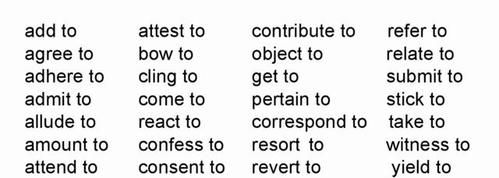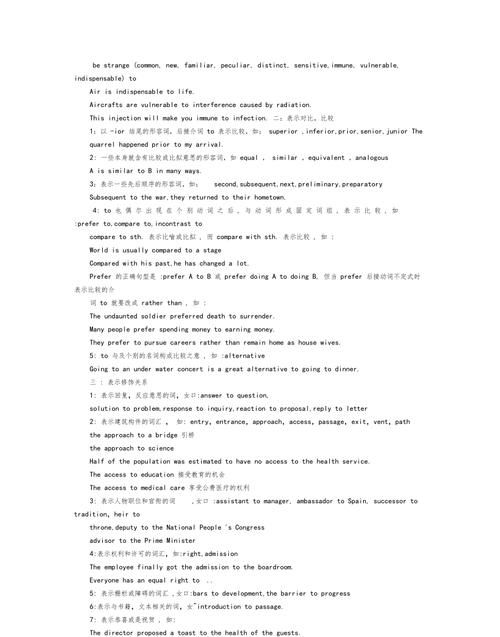本文目录
to的用法
To 和 for 的区别:一般情况下, to后面常接对象; for后面表示原因与目的为多。
1、to sb.表示对某人有直接影响比如,食物对某人好或者不好就用to;
2、for表示从意义、价值等间接角度来说,例如对某人而言是重要的,就用for。
3、for和to这两个介词,意义丰富,用法复杂。
搜狗问问
扩展资料
for
英语单词简介
for后加动名词
人称加宾格
to
prep.
向,往,给...,于...,直到...为止,在...之前,比,对,[表示程度、范围] 到,达
情态动词后不加to直接加v.(原)
行为动词加to do sth.(如:need)
(表示时间)到, 直到, 在…到来之前, 离…; 例:from seven to ten
(表示方向)朝, 往, 通向

for.to的用法大全通俗易懂
continue to do 继续做某事
go on to do 继续做某事
start/ begin to do 开始做某事
hate to do 讨厌做某事
love to do喜欢做某事
look forward to doing 期待做某事
be used to do 被用于
used to do 过去常常做某事
be used to doing 习惯于做某事
be allowed to do 被允许做某事
be made to do 被让去做某事
tell sb not to do 让某人不做某事
hope/wish to do 希望做某事
send sb to do 派某人做某事
pay attention to doing 注意做某事

to的用法
to 可以是介词,也可以是结构助词。
1、作介词用的时候,后面跟名词或动名词,如:give the book to Tom. I am looking forward to seeing you.
2、作结构助词用的时候,是作不定式,也就是to do 形式,后面必须跟动词原形。如:want to do , be going to do 。
现将常见的介词带to的短语归纳如下:
be / get / become used to 习惯于
be related to 与…有关系
be addicted to 沉溺于;对…上瘾
be opposed to 反对
devote oneself to献身于;专心于
be devoted to 致力于;忠诚于
be admitted to 被…录取;准进入
be reduced to 沦为
reduce…to…使…沦为
be attached to 附属于;喜欢;依恋
be adjusted to 适应
be known to 为…所知
be married to 和…结婚
be sentenced to被判处
be connected to 和…连在一起
be exposed to 暴露于;遭受
be compared to 被比喻成
compare… to…把…比作…
be engaged to 与…订婚
be / become / get accustomed to // accustomed to 惯于;有…习惯

to的用法口诀小学
to 可以是介词,也可以是结构助词。作介词用的时候,后面跟名词或动名词,比如:give the book to Tom. i am looking forward to seeing you. 至于什么时候用to,介词的用法都是固定搭配的,与其记住很容易混淆的多种含义,不如直接背固定词组。
坐结构助词用的时候,是做不定式,也就是to do 形式,后面必须跟动词原形。也可以理解为一种固定搭配,比如want to do , be going to do 。所以最好也是记住固定词组。
情态动词后不加to直接加v.(原)
行为动词加to do sth.(如:need)
(表示时间)到, 直到, 在…到来之前, 离…; 例:from seven to ten
(表示方向)朝, 往, 通向
(表示状态)紧贴着, 紧靠着, 对着;
(表示对象)对, 对于, 对…来说;
(表示比较)比, 相对于;
(表示方位)在…方向[方位], 处于…顺序;
(表示距离)离, 距离;
(表示目标)到达, 直到;
(表示结果)转换为, 转变为, 趋于;
(表示修饰)———的。

扩展资料:
To
1.向;至;往:She's going to London.她要去伦敦。Turn to the left.向左转。Pisa is to the west of Florence. 比萨在佛罗伦萨的西面。He has gone to school.他上学去了。
2.(用于表示一系列事物或一段时间的尽头或限度) 直到:from Monday to Friday从星期一到星期五 from beginning to end 从开始到结束。
3.用于表示接受者:Give that to me.把那个给我。I am very grateful to my parents.我很感激我的父母。What have you done to your hair?你把头发怎么搞的?Sorry I didn't realize you were talking to me.对不起,我不知道你是在跟我说话。
4接触到;针对:He put his hands to his ears.他将两手捂住耳朵。They sat back to back.他们背对背坐着。She made no reference to her personal problems.他没有提及自己的个人问题。
5.达到某种状态:The meat was cooked to perfection.这肉煮得恰到好处。His speech reduced her to tears(=make her cry).他的话令她流泪。
6.(用于引出比较中的另一部分):I prefer theatre to opera.我喜欢戏剧,甚于歌剧。
7.(用于表示数量每```等于:How many dollars are there to the euro?多少美元等于一欧元?
8.(用于表示时间)在```之前:It's ten to three.(=ten minutes before three o'clock).现在是三点差十分。
9.(用于表达对某物的看法或感受):To me,it was the wrong decision.我认为那是错误的决定。It sounded liked a good idea to me.我觉得这听起来是个好主意。I don't think our friendship means anything to him.我认为我们的友谊对他说毫不重要。
10.(用于表达某人对某事的反应或态度):To my surprise,I saw two strangers coming out of my house.我看见两个陌生人从我家里走出来,吃了一惊。His paintings aren't really to my taste.他的画真的不符合我的口味。
11.(与动词连用,构成不定式。):I want to go home now.我现在想回家。Don't forget to write.别忘记写信来。I didin't know what to do.我当时不知道该怎么办。
12.(指门)关上Push the door to.把门推一推关上。
参考资料:百度百科---to
以上就是关于to的用法大全通俗易懂 ,to的用法的全部内容,以及to的用法大全通俗易懂 的相关内容,希望能够帮到您。
